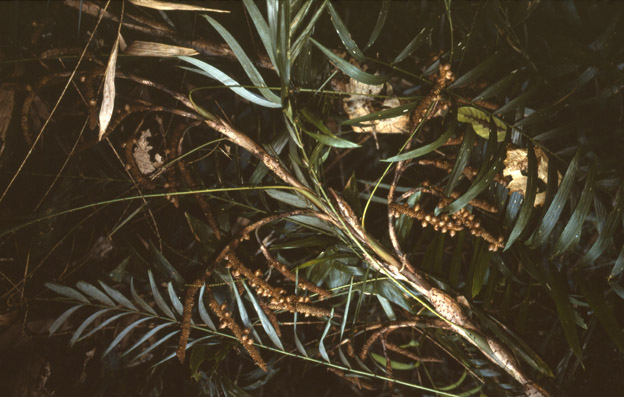- Acanthophoenix
- Acrocomia
- Actinokentia
- Actinorhytis
- Adonidia
- Aiphanes
- Allagoptera
- Ammandra
- Aphandra
- Archontophoenix
- Areca
- Arenga
- Asterogyne
- Astrocaryum
- Attalea
- Bactris
- Balaka
- Barcella
- Basselinia
- Beccariophoenix
- Bismarckia
- Borassodendron
- Borassus
- Brassiophoenix
- Burretiokentia
- Butia
- Calamus
- Calyptrocalyx
- Calyptrogyne
- Calyptronoma
- Carpentaria
- Carpoxylon
- Caryota
- Ceratolobus
- Ceroxylon
- Chamaedorea
- Chamaerops
- Chambeyronia
- Chelyocarpus
- Chuniophoenix
- Clinosperma
- Coccothrinax
- Cocos
- Corypha
- Cryosophila
- Cyphokentia
- Cyphophoenix
- Cyphosperma
- Daemonorops
- Deckenia
- Desmoncus
- Dictyocaryum
- Drymophloeus
- Dypsis
- Elaeis
- Eleiodoxa
- Eremospatha
- Eugeissona
- Euterpe
- Gaussia
- Geonoma
- Guihaia
- Hedyscepe
- Hemithrinax
- Howea
- Hyophorbe
- Hyospathe
- Hyphaene
- Iriartea
- Iriartella
- Itaya
- Jailoloa
- Johannesteijsmannia
- Juania
- Jubaea
- Jubaeopsis
- Kentiopsis
- Kerriodoxa
- Laccospadix
- Laccosperma
- Lanonia
- Latania
- Lemurophoenix
- Leopoldinia
- Lepidocaryum
- Lepidorrhachis
- Leucothrinax
- Licuala
- Linospadix
- Livistona
- Lodoicea
- Lytocaryum
- Manicaria
- Manjekia
- Marojejya
- Masoala
- Mauritia
- Mauritiella
- Maxburretia
- Medemia
- Metroxylon
- Myrialepis
- Nannorrhops
- Nenga
- Neonicholsonia
- Neoveitchia
- Nephrosperma
- Normanbya
- Nypa
- Oenocarpus
- Oncocalamus
- Oncosperma
- Orania
- Oraniopsis
- Parajubaea
- Pelagodoxa
- Phoenicophorium
- Phoenix
- Pholidocarpus
- Pholidostachys
- Physokentia
- Phytelephas
- Pigafetta
- Pinanga
- Plectocomia
- Plectocomiopsis
- Podococcus
- Pogonotium
- Ponapea
- Prestoea
- Pseudophoenix
- Ptychococcus
- Ptychosperma
- Raphia
- Ravenea
- Reinhardtia
- Retispatha
- Rhapidophyllum
- Rhapis
- Rhopalostylis
- Roscheria
- Roystonea
- Sabal
- Sabinaria
- Salacca
- Saribus
- Satakentia
- Satranala
- Schippia
- Sclerosperma
- Socratea
- Solfia
- Sommieria
- Syagrus
- Synechanthus
- Tahina
- Tectiphiala
- Thrinax
- Trachycarpus
- Trithrinax
- Veitchia
- Verschaffeltia
- Voanioala
- Wallaceodoxa
- Wallichia
- Welfia
- Wendlandiella
- Wettinia
- Wodyetia
- Zombia
- x Jubautia splendens
- ?? Acoelorrhaphe
- ?? Bentinckia
- ?? Brahea
- ?? Clinostigma
- ?? Colpothrinax
- ?? Copernicia
- ?? Cyrtostachys
- ?? Dictyosperma
- ?? Dransfieldia
- ?? Heterospathe
- ?? Hydriastele
- ?? Iguanura
- ?? Incertae sedis & excluded names
- ?? Loxococcus
- ?? Micronoma
- ?? Paripon
- ?? Pritchardia
- ?? Rhopaloblaste
- ?? Serenoa
- ?? Washingtonia

Distribution
Very widespread throughout Brunei. Elsewhere widespread in Borneo, Sumatra and the southern part of Peninsular Malaysia. (Dransfield, J. 1997: The Rattans of Brunei Darussalam)A
Discussion
- K. echinometra is perhaps the commonest species of the genus. It is a very distinctive species, though confusingly like a rattan other than a species of Korthalsia when viewed from a distance. The very spiny swollen ocrea and narrow leaflets are diagnostic. (Dransfield, J. 1997: The Rattans of Brunei Darussalam)A
Biology And Ecology
- It occurs in lowland and hill dipterocarp forest up to 1000 m above sea level. (Dransfield, J. 1997: The Rattans of Brunei Darussalam)A
Etymology
- Spiny pudenda (Dransfield, J. 1997: The Rattans of Brunei Darussalam)A
Common Name
- Wi Keruk, Wi Wisro (Ib.) (Dransfield, J. 1997: The Rattans of Brunei Darussalam)A
Uses
- Much sought after for use, split, in basket weaving and for basket frames. (Dransfield, J. 1997: The Rattans of Brunei Darussalam)A
Description
- Moderately robust clustering and branching rattan climbing to 40 m. Stem without sheaths to 2 cm diam., with sheaths to 3 cm. diam., internodes rather short to 12 cm. Sheaths bright green, sparsely armed, almost completely covered by the ocreas; ocrea to 10 × 5 cm, grossly swollen, densely covered with long black spines to 6 cm long; ants abundant within the ocreas. Leaf to 1.8 m including the cirrus to 70 cm and petiole to 10 cm or more. Leaflets numerous, c. 25 on each side of the rachis, narrowly elongate, to 30 × 3 cm, dark green on the upper surface, chalky- white beneath, praemorse only in the distalmost 3-6 cm. Inflorescences to c. 60 cm long, with up to 15 rachillae in each; rachillae to 20 × 1.5 cm, reddish-brown tomentose. Mature fruit ovoid, 2.5 × 1.5 cm, covered in 18-21 vertical rows of reddish- brown scales. Seed to 15 × 10 mm; endosperm ruminate. Seedling leaf bifid with narrow leaflets. (Fig. 6, Pl. 2C, 2D). (Dransfield, J. 1997: The Rattans of Brunei Darussalam)A
Materials Examined
- BEL: Sungai Liang, Sungei Liang Arboretem, Wong 143. TEM: Amo, K.Belalong, Dransfield J. 6721; Batu Apoi, Bt.Gelagas (Bt.Suang), Simpson 2365. Without prov.: BRUN 15126. (Dransfield, J. 1997: The Rattans of Brunei Darussalam)A
- Log in to post comments

